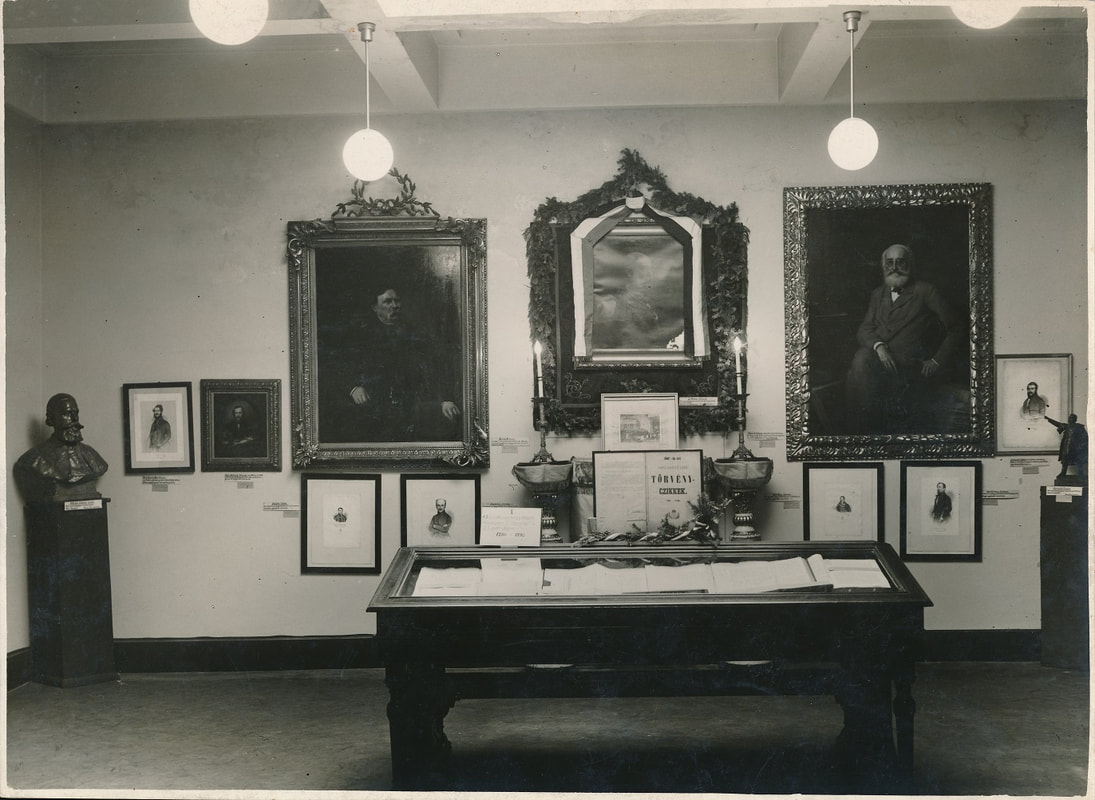|
A Magyar zsidó Múzeum állandó kiállítása az épület első emeletén 1932. december 26-án nyílt meg. Itt az akkor mintegy kétezer tárgyból álló gyűjtemény szinte minden darabját kiállították. Az első teremben a magyarországi zsidók történetére vonatkozó dokumentumokat, a másodikban a magánhagyatékokban fennmaradt régiségeket, míg a harmadik, már a zsinagóga toronyépületében lévő teremben a zsinagógai szakrális tárgyakat állították ki. A kiállításnak, a múzeumegyesület szándékai szerint, a zsidó látogatók kulturális identitásának, öntudatának erősítését, a nem zsidó látogatók ban pedig a közös történelemre utaló tárgyak és dokumentumok hangsúlyozásával a zsidó–keresztény testvériség érzését kellett szolgálnia. Az 1938 tavaszán meginduló antiszemita törvénykezés mélyen megrázta a hazafias érzelmű, asszimilált zsidóságot. A kormányzathoz lojális zsidó vezetők, akikben rendíthetetlenül élt a magyar állam intézményeibe és a politikai elitbe vetett bizalom, a parlament mindkét házához és a kormányzóhoz intézett, történelmi, jogi és erkölcsi érveket felsorakoztató memorandumokkal, a magyar társadalom lelkiismeretét megszólító vitairatokkal igyekeztek a fenyegető veszedelmet elhárítani – sikertelenül. A Magyar Zsidó Múzeumban 1938 márciusában megrendezett „Emancipációs kiállítás” fellebbezés volt a közvéleményhez: az 1867-ben meghozott emancipációs törvény történeti előzményeinek, politikai, szellemi környezetének bemutatásával Kossuth Lajos, Szemere Bertalan, Deák Ferenc, Eötvös József jogegyenlőséget hirdető, szabadelvű humanizmusára apellált, pedig ekkor a magyar közgondolkodásban ezeket az eszméket már csak egy háttérbe szorult, elenyésző kisebbség képviselte. A kiállítás bejáratánál kifüggesztett szöveg idézte a magyarországi zsidók közösségének az 1790-es országgyűléshez intézett folyamodványát, melyben jogaik kiterjesztését kérik. Az utolsó terem középpontjába a zsidók egyenjogúsítását kimondó 1867. XVII. törvénycikknek az uralkodó, I. Ferenc József által aláírt eredeti példányát helyezték el a rendezők. Bal szélén Kohn Sámuel főrabbi, jobb szélén Kossuth Lajos szobrát látjuk. A zárófal közepén I. Ferenc József, Deák Ferenc, jobbra Tisza Kálmán portréja függ. A kiállítást összeállította: Grünvald Fülöp Rekonstrukció: Toronyi Zsuzsanna A kiállítás katalógusának digitalizált változata: KATALÓGUS 1938 A katalógus alapján az 1938-ban kiállított tárgyak: KIÁLLÍTÁS1938 The permanent collections of the Jewish Museum were presented to the public on December 26, 1932, with almost all of its approximately 2,000 items on display. The first exhibition room contained documents illustrating the history of Jews in Hungary, the second archeological objects deriving from private inheritances, and the third room was in the synagogue tower and presented devotional objects. The two aims of the exhibition were to promote a sense of identity and self-confidence among Jewish visitors and to remind others of the common Judeo-Christian history and brotherhood. The wave of anti-Semitic legislation from spring 1938 was a profound shock to assimilated Jews since they were deeply patriotic and, like most Nationalists, were of the opinion that the Treaty of Trianon had unfairly devested the country of territories that were indisputably Hungarian and for this reason needed to be revised. The two houses of Parliament and to Regent Horthy, presenting historical, legal and ethical arguments. But to no avail. The exhibition organized in the Jewish Museum in March 1938, was an appeal to public opinion. It recalled the antecedents, the political and intellectual context of the 1867 emancipation law and the support of national heroes and icons the likes of Lajos Kossuth, Bertalan Szemere, Ferenc Deák and József Eötvös. But this could only convince believers in equality and liberal humanism – ideas that had survived only amongst the minority that made up public opinion. A poster at the entrance to the exhibition quoted the application for equal rights to the 1790 parliament as drafted by the Jewish community at the time. In the center of the last gallery, the original of Law XVII/1867, signed by the Emperor Franz Joseph, was displayed. on the left stood the statue of Chief Rabbi Sámuel Kohn; on the right that of Lajos Kossuth. The closing wall of the final room showed the portraits of Franz Joseph in the center, Ferenc Deák on the left and Kálmán Tisza on the right. Curator of the exhibition: Philipp Grünvald Reconstruction: Zsuzsanna Toronyi Catalog of the exhibition (Hungarian): Catalog1938 Objects on display (reconstruction): Exhibition1938
1 Comment
|
Tartalom:A Magyar Zsidó Múzeum és Levéltár kiállításai Categories |

 RSS Feed
RSS Feed